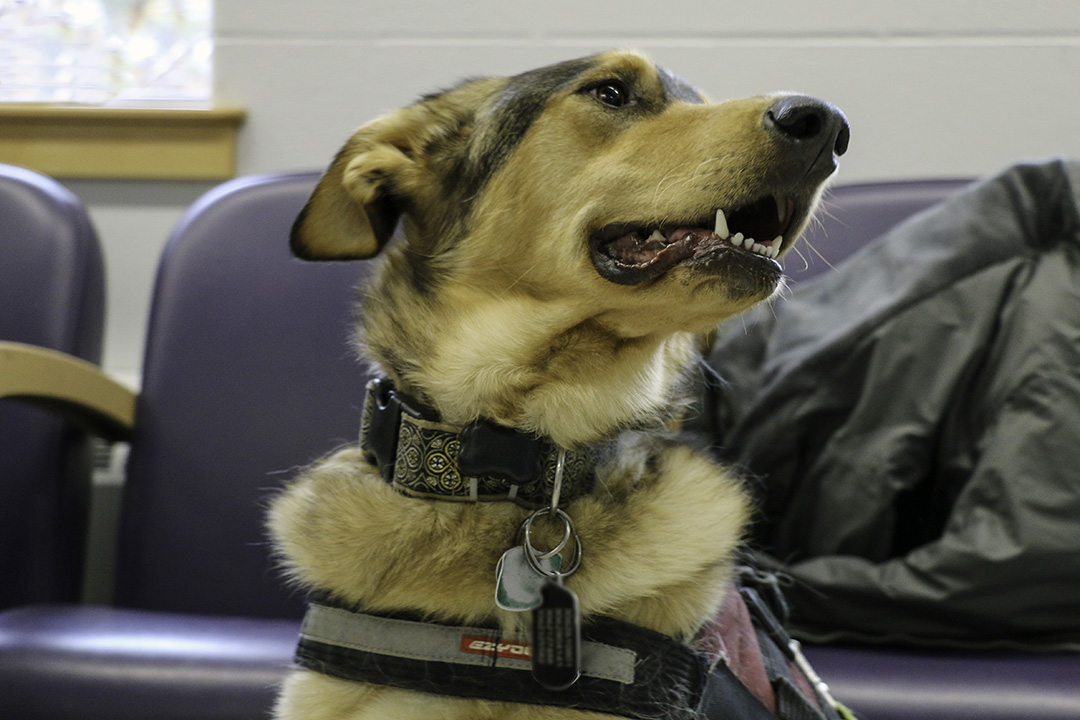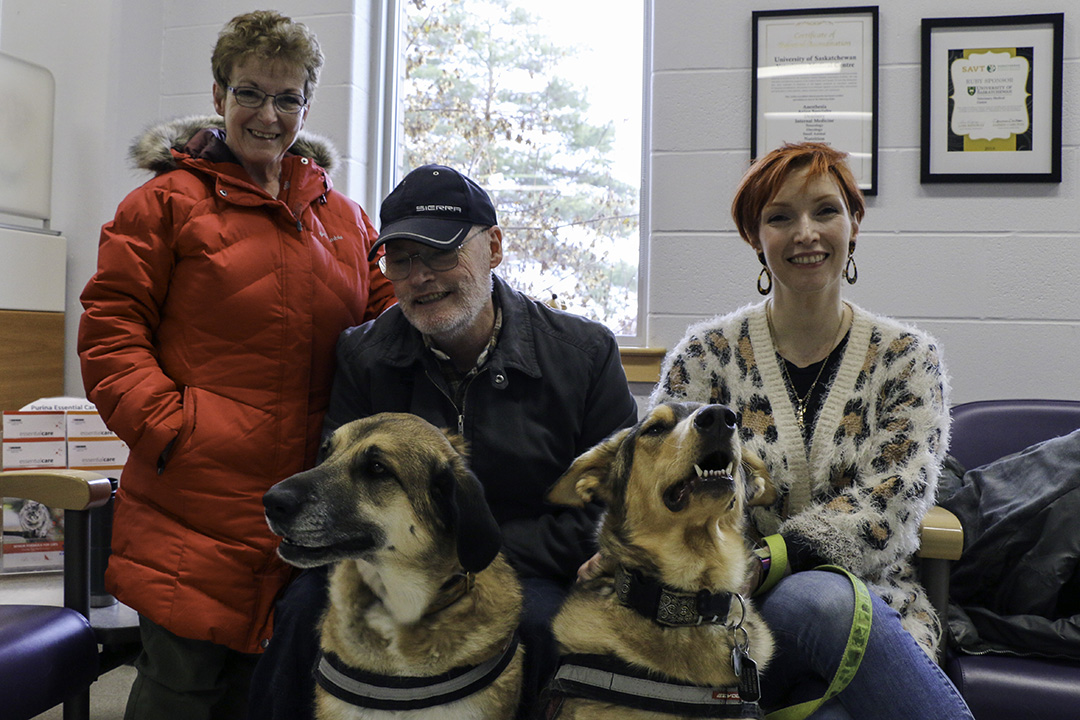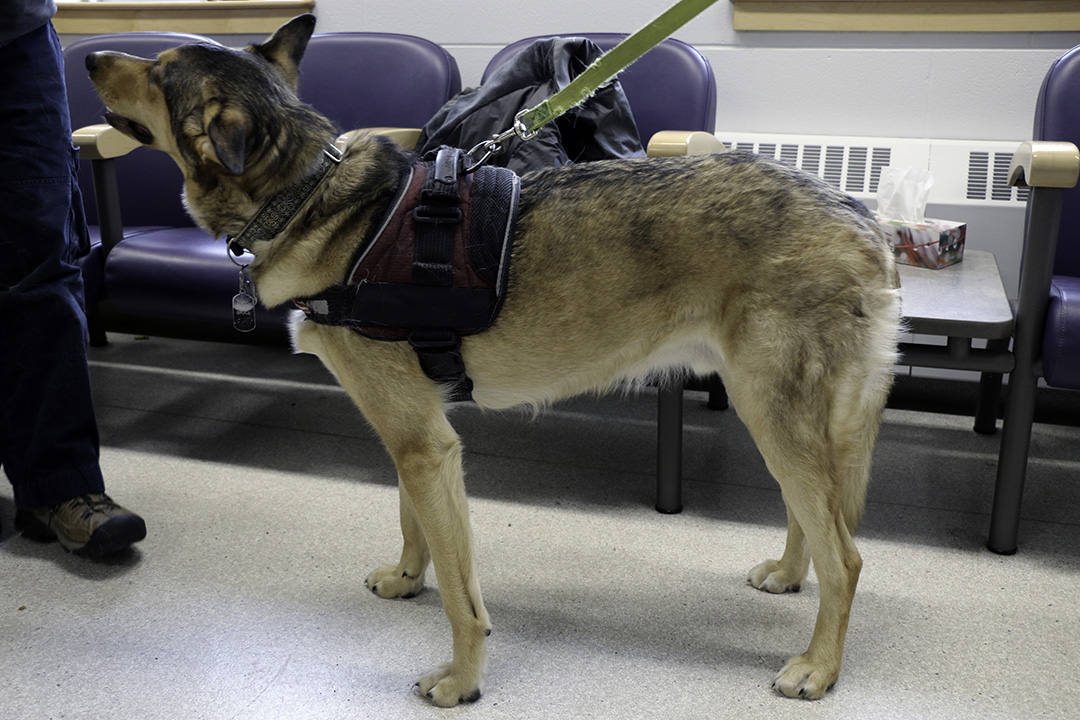
Bruce’s happy before and after
Dennis Fehr brought his dog Bruce to the Western College of Veterinary Medicine (WCVM) Veterinary Medical Centre (VMC) in December 2018 because of a clunking noise in his pet’s hip.
By Katie Brickman-Young
“Bruce was having severe hip problems. We could hear his hips clicking when he walked,” says Fehr. “We took him into the VMC and the surgeon said he needed a full hip replacement.”
At two and a half years old, Bruce weighed 43.7 kilograms (96 pounds) with a body condition score of eight out of nine, meaning he had a much higher body fat percentage. The malamute-cross dog had very little muscle over his thigh and rear end, which meant recovery from surgery would be difficult and might fail. Bruce was also on pain medication and was lame on his left hind leg.
WCVM small animal surgeon Dr. Adrien Aertsens decided Bruce needed to lose some weight first. That’s when the Fehr family met Dr. Tammy Owens and registered veterinary technologist Kristi Harms of the VMC’s clinical nutrition service.
“At that time, the goal was to have him lose enough weight that he would be a better surgical candidate,” says Owens, a board-certified small animal clinical nutritionist. “I estimated he had a body fat percentage of 40 per cent and my goal was to get him back to his ideal body condition.”
Step one was for the Fehr family to start tracking everything Bruce ate and his daily exercise.
“We sat down with them, and they made up a plan for Bruce around nutrition and diet,” says Fehr. “We started walking him 10 minutes a walk and then up to 15 minutes and then slowly up to 20 minutes per walk a day, three times a day."
Fehr brought Bruce into the WCVM's Small Animal Clinic for monthly appointments and weigh-ins, but it wasn’t always easy.
Timid by nature, the dog hid under his owner’s chair in the exam room, and Fehr had to carry Bruce out of the building after each appointment.
The check-ins eventually became a family affair with Fehr, his wife Connie, his daughter Jennifer and their dog Karm coming into the clinic so Bruce didn’t feel so out of place. Owens, Harms and veterinary students also helped Bruce feel more at ease using patience and ‘fear-free’ techniques.
“When we first saw them, Bruce was so nervous. But they all walked in and sat on the floor with him,” says Fehr. “In his last appointment, he walked into the middle of the room, sat down and shook everyone’s paw. It was amazing the way they treated us.”
Part of creating a plan was getting a better understanding of his food intake and then changing those behaviours so he could lose the body fat and get stronger.
“This was our fault. We were all giving Bruce treats and not telling the other person what and when we were giving him treats,” says Fehr. “We were the problem, not Bruce. He wasn’t making the poor food choices — we were. Everyone worked with us, helping us, educating and encouraging us without ever criticizing what we had been doing.”

No more 'Sausage Brucie'
Owens explained that pet obesity is a common problem for a lot of reasons.
“I don’t find fault with the pet owners. Calories in pet food and treats can be unclear, and it is easy for them to add up quickly,” said Owens. “Once the problem exists, it can be hard work to trim down, but that’s why we are here to help.”
Over the next eight months, the Fehr family worked with Bruce to balance the number of calories coming in and how many calories were being burned, without restricting the nutrients and protein he needed to build muscle.
“It can be detrimental when calories and nutrient intake are restricted. That can have negative effects on metabolism and can create nutrient deficiencies,” explains Owens. “We are focused on not just changing the number of calories, but also changing where those calories are coming from. So the type of food, the nutrient distribution, and energy density of that food are all important.
“We want to use high fibre, low calorie, nutrient-dense food with plenty of protein, so Bruce isn’t feeling hungry and is still getting all the nutrition his body needs while reducing that calorie intake.”
In Bruce’s final check-in on Feb. 25, 2020, he was 36 kg (79 lb.) for a total weight loss of 6.1 kg (13.5 lb.) of body weight.
“He lost at least 20 per cent body fat,” says Owens. “His weight didn’t change as much as expected, because while he was losing body fat, he was gaining muscle.”
His body conditioning score is now an ideal four out of nine, which was the best outcome that Owens could have asked for.
“These are the kinds of cases that make all the time and effort more than worth it,” says Owens. “Bruce’s family was amazing, and a big part of this was that we were able to establish a good rapport. Ultimately, the credit rests with them.”
Best of all, the VMC’s surgical team determined that because of Bruce’s muscle gain, his lameness was gone. He didn’t need the hip replacement after all.
Hearing that Bruce wouldn’t have “to go through all that pain was like a thousand Christmases,” says Fehr. “The nutrition people saved Bruce from having to go through with that surgery. They are so dedicated, and Bruce is special to them.”
Fehr recently retired and spends his time with Bruce and Karm on walks, averaging about 10 kilometres a day.
“They are our life. We are a household where our lives revolve around our dogs,” says Fehr. “We love them, and they are a part of our family. Every day we look at Bruce and think wow. He will never be ‘Sausage Brucie’ again.”
Click here to read more stories in the Summer 2020 issue of Vet Topics, publication for the Companion Animal Health Fund.
